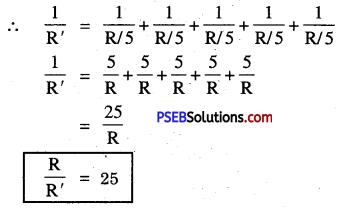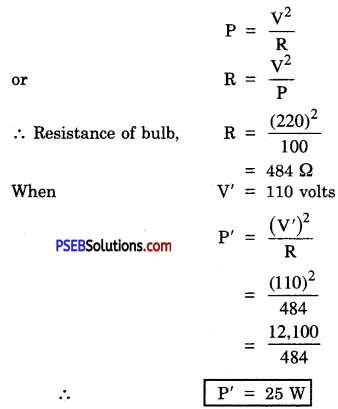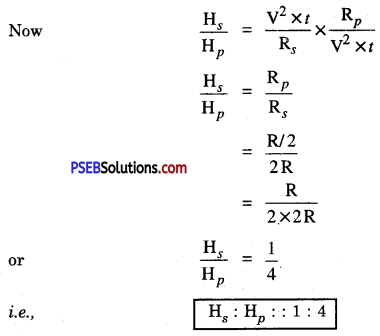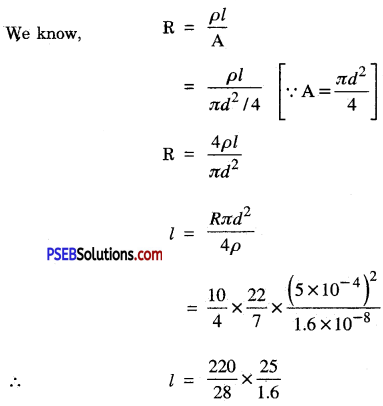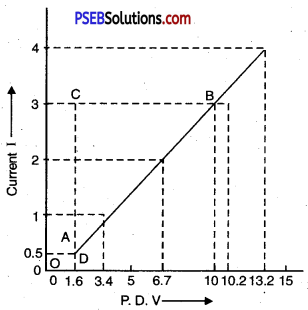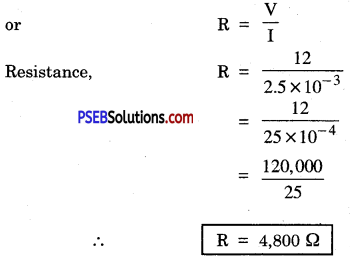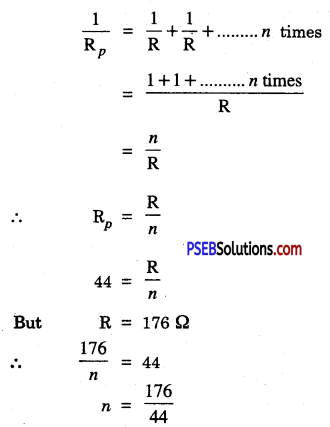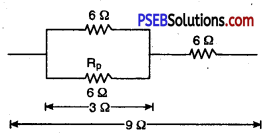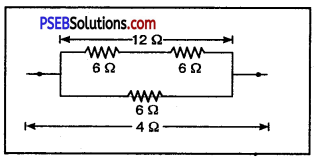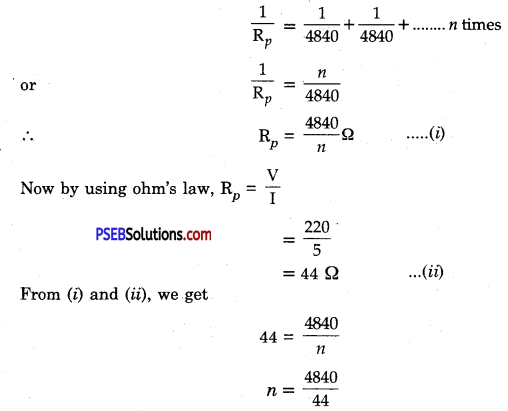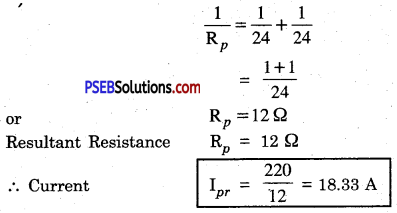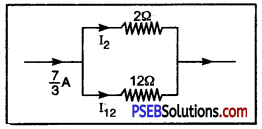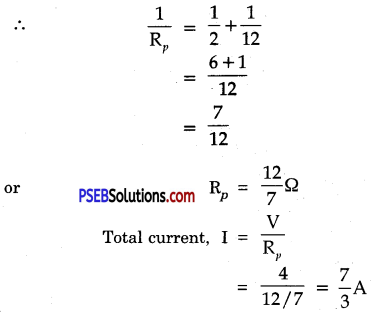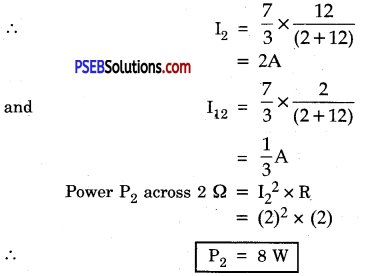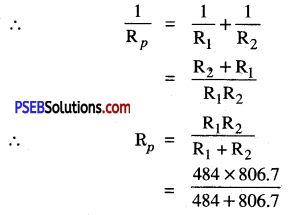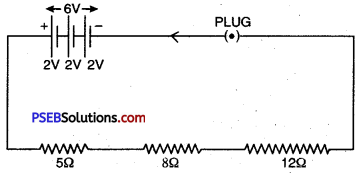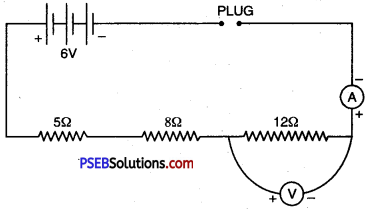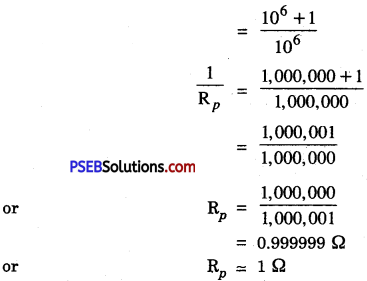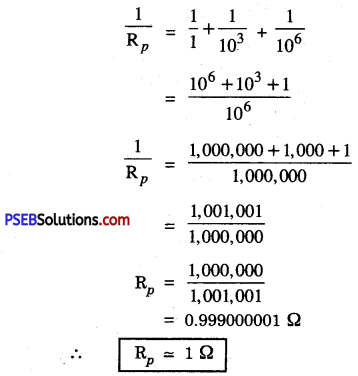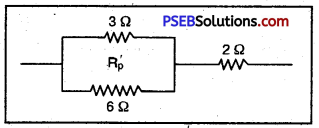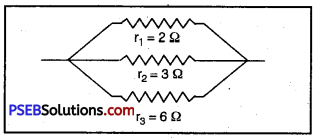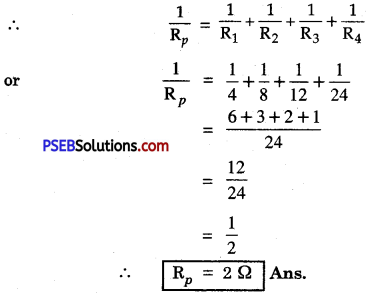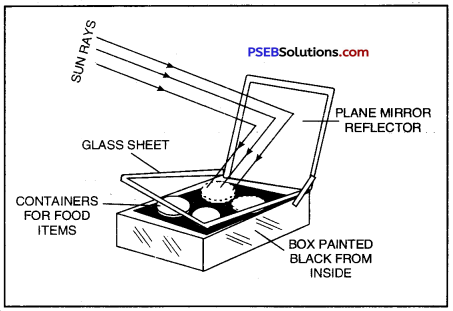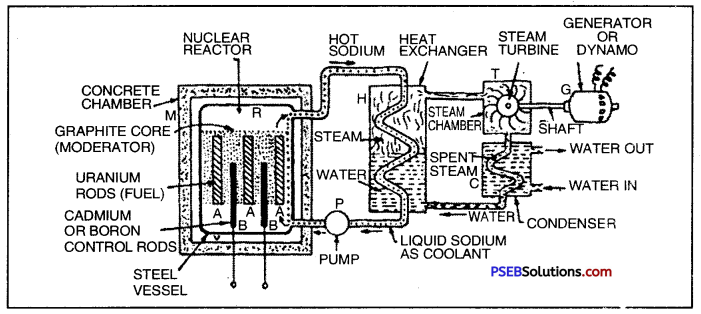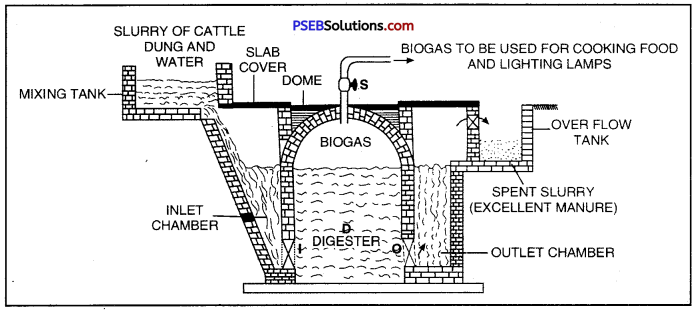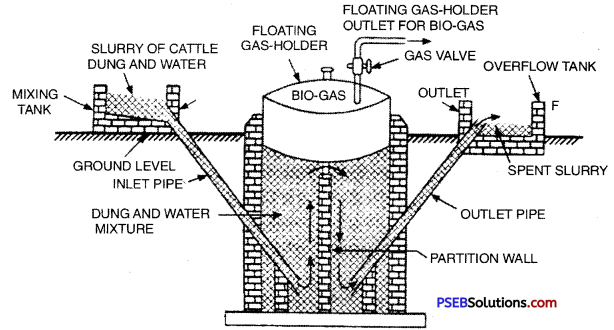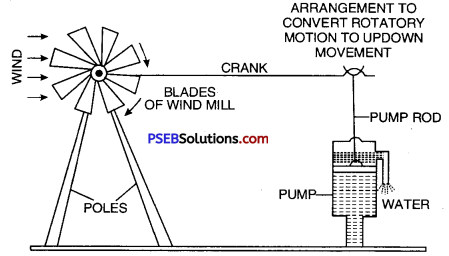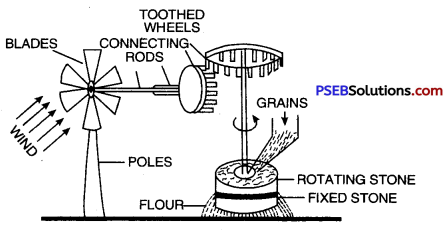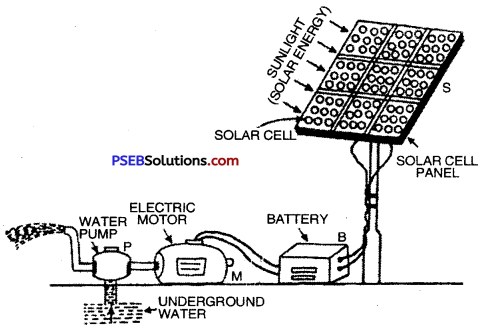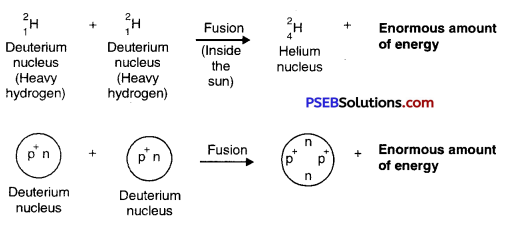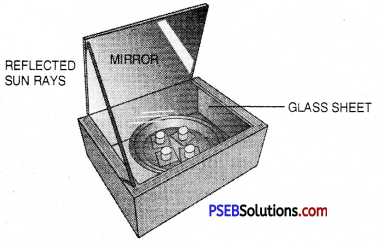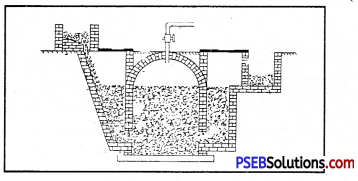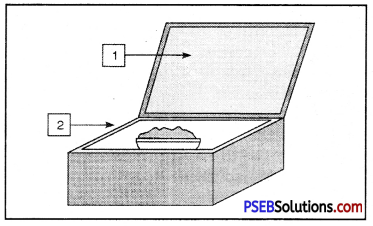Punjab State Board PSEB 10th Class English Book Solutions English Grammar Non-Finites Exercise Questions and Answers, Notes.
PSEB 10th Class English Grammar Non-Finites
(Answer Key has been given at the end of the exercises.)
Complete the following sentences, using the Infinitive form (with or without to) of the verbs given in brackets.
1. You are requested …………… me. (help)
2. She bade us ……………… away. (go)
3. I find the word ‘psychology difficult ………. . (spell)
4. Please make me …………… why the stars twinkle. (understand)
5. The medicine is too bitter …………. (take)
Answer:
1. to help
2. go
3. to spell
4. understand
5. to take.

Replace the Relative Clause in each of the following sentences by an Infinitive.
Example : You have some important work which you must finish.
Answer :
You have some important work to finish.
1. You have a train that can carry you back home.
2. She wants something that she can drink.
3. They advised me that I should see an eye specialist.
4. Mohan had no proof that he could show.
5. I gave him a book that he could consult.
6. Asha is not a servant who can be trusted.
Answer:
1. You have a train to carry you back home.
2. She wants something to drink.
3. They advised me to see an eye specialist.
4. Mohan had no proof to show.
5. I gave him a book to consult.
6. Asha is not a servant to be trusted.
Rewrite the following sentences, using an Infinitive.
1. I would be happy if I could join this company. (to join).
2. At Agra, we have the Taj that one can visit.
3. His handwriting is so bad that one cannot read it…
4. Papa was angry when he found that his glasses were broken.
5. I was shocked when I heard of the terrible accident.
6. I will tell him that he should post the letter today.
Answer:
1. I would be happy to join his company.
2. At Agra, we have the Taj to visit.
3. His handwriting is too bad to read.
4. Papa was angry to find that his glasses were broken
5. I was shocked to hear of the terrible accident.
6. I will tell him to post the letter today.
Combine the following pairs of sentences, using a Present Participle or a Past Participle. Treat the first two sentences as examples.
1. I felt sorry for the blind man. I gave him a hundred-rupee note.
2. My uncle arrived. He was accompanied by Mohan.
3. We found the child. It was crying for its father.
4. He raised his sword. He struck his enemy.
5. I heard the bang. I sprang up from my bed.
6. He broke his leg. It made it difficult for him to walk.
7. The child was lost. He found no joy in the fair.
Answer:
1. Feeling sorry for the blind man, I gave him a hundred
2. Accompanied by Mohan, my uncle arrived.
3. We found the child crying for its father.
4. Raising his sword, he struck his enemy.
5. Hearing the bang, I sprang up from my bed.
6. Having broken his leg, it became dificult for him to walk
7. The lost child found no joy in the fair.
Combine the following sets of sentences, using a Non-finite verb (Infinitive, Gerund, or Participle).
1. I enjoyed the mangoes. These were sent by my uncle.
2. We go to the library. We read books there.
3. I am happy. I accept your invitation.
4. He took his gun. He fired at the bird.
5. She left home early. She arrived here on time.
6. He wants to marry Mary. His father is opposed to this.
7. Mohan sells apples. He earns fifty rupees a day.
8. It was an extremely cold day. I could not work at all. (Start with : It being ……….)
9. They held a meeting. They discussed the matters of the school.
10. I went to the Headmaster. I sought a favour.
Answer:
1. I enjoyed the mangoes sent by my uncle.
2. We go to the library to read books.
3. I am happy to accept your invitation.
4. Taking his gun, he fired at the bird.
5. Leaving her home early, she arrived here on time
6. His father is opposed to his marrying Mary
7. Selling apples, Mohan earns fifty rupees a day
8. It being an extremely cold day, I could not work at all. Go
9. They held a meeting to discuss the matters of the school.
10. I went to the Headmaster to seek a favour.

Fill in the blanks with suitable Non-finites (Infinitive, Gerund or Participle).
1. I am afraid of ……………… in the court. (appear)
2. ………………. thieves in her house, she started …………. (see, shout)
3. He decided ……….. his income by ……. a private tuition. (increase, take)
4. I noticed your friend …………. with a gambler. (sit)
5. It is easier …………. than ……….. (say, do)
6. Do you want ……….. my address ? (know)
7. Every miser hates …………. money. (spend)
8. They were eager ……….. the game. (start)
9. This rent is quite reasonable for a well …………. house. (furnish)
10. The children seemed ………….. on seeing the giant. (frighten)
Answer:
1. appearing
2. Seeing, shouting
3. to increase, taking
4. sitting
5. to do
6. to know
7. spending
8. to start
9. furnished
10. frightened.
Combine the following sets of sentences into a single sentence each.
1. Mohan is trying. He wants to follow Gandhiji.
2. The Chairman tried it. He wanted to put him off.
3. Mohan did not look at the girls. He avoided it.
4. The old man took the trouble of it. He explained the matter in detail.
5. It is no use. Don’t cry over spilt milk.
6. Hari does not accept bribes. He hates it.
7. You should not blow horn near a hospital. It is forbidden.
8. He stole the ornaments. He looked for a place to hide them.
9. I saw a gentleman. He was sitting next to me.
10. He stood aside. He was waiting for orders.
Answer:
1. Mohan is trying to follow Gandhiji.
2. The Chairman tried to put him off.
3. Mohan avoided looking at the girls.
4. The old man took the trouble of explaining the matter in detail
5. It is no use crying over spilt milk
6. Hari hates accepting bribes.
7. It is forbidden to blow a horn near a hospital.
8. Having stolen the ornaments, he looked for a place to hide them.
9. I saw a gentleman sitting next to me.
10. Standing aside, he was waiting for orders.
यदि कोई क्रिया कर्ता के वचन (number) और पुरुष (person) के प्रभाव से मुक्त हो तो उसे Non-finite Verb कहा जाता है; जैसे
1. I want to dance.
2. She wants to dance.
3. They want to dance.
4. Radha wants to dance.
ऊपर दिए गए वाक्यों में क्रिया dance पर कर्ता का कोई प्रभाव नहीं पड़ा है। इसलिए इसे Non-finite (असीमित अर्थात् बिना बन्धन) क्रिया कहा जाता है।

Non-finites तीन प्रकार के होते हैं
1. The Infinitive
(a) Bare Infinitive
(b) To-infinitive.
2. The Gerund
3. The Participle
(a) Present Participle
(b) Past Participle
(c) Perfect Participle.
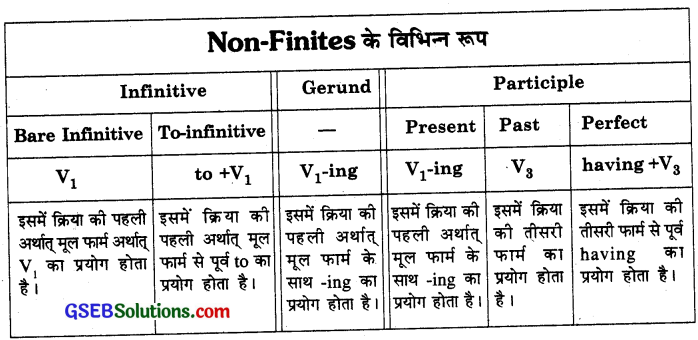
Bare Infinitive का प्रयोग
Bare Infinitive (to के बिना infinitive) का प्रयोग निम्नलिखित स्थितियों में किया जाता है
1. निम्नलिखित सहायक क्रियाओं (Modal Auxiliaries) के बाद :
do, does, did, can, could, will, would, shall, should, may, must, might, need, dare.
1. He may come today.
2. I shall accompany you.
3. I can play cricket.
4. You need not do it.
5. She dare not come here.
नोट : need और dare का प्रयोग जब मुख्य क्रियाओं के रूप में किया गया हो तो इनके साथ to- infinitive का प्रयोग किया जाता है; जैसे
1. He didn’t dare to come here.
2. You don’t need to go there.
नोट : सहायक क्रियाओं ought और used के बाद भी to-infinitive का प्रयोग किया जाता है; जैसे
1. You ought to finish your work.
2. He used to come here daily.
2. निम्नलिखित सकर्मक (Transitive) क्रियाओं के बाद :
make, let, bid, feel, hear, see, watch, notice, observe, आदि क्रियाओं के बाद bare infinitive का प्रयोग किया जाता है जब ये क्रियाएँ Active Voice में हों; जैसे
1. I saw him steal my pen.
2. I heard him go up the stairs.
3. I felt the cold air strike against my face.
किन्तु hear, make तथा see का प्रयोग जब Passive Voice में किया गया हो तो इनके बाद to-infinitive का प्रयोग किया जाता है; जैसे
1. He was heard to say all this.
2. She was made to dance.
3. He was seen to enter the office.
नोट : feel, hear, see तथा watch के बाद प्रायः -ing वाली क्रिया अर्थात् Present Participle का प्रयोग भी किया जाता है; जैसे

1. I saw him leaving the office. (Active)
2. He was seen leaving the office. (Passive)
3. I heard her shouting at him. (Active)
4. She was heard shouting at him. (Passive)
3. had और would वाले निम्नलिखित phrases के बाद : had better, had rather, would rather, had sooner, would sooner.
1. I would rather die than beg.
2. You had better stop smoking.
4. than, but तथा except के बाद जब इनका प्रयोग conjunction के रूप में किया गया हो; जैसे
1. He did nothing but laugh.
2. I could do nothing except agree to it.
3. I would rather walk than ride your scooter.
नोट : but के बाद bare-infinitive का प्रयोग केवल तभी किया जाता है जब but से पूर्व मुख्य क्रिया के रूप में do, does अथवा did का प्रयोग किया गया हो।
To-infinitive का प्रयोग
To-infinitive का प्रयोग निम्नलिखित स्थितियों में किया जाता है
1. ought और have के बाद to-infinitive का प्रयोग किया जाता है यदि इन शब्दों का प्रयोग किसी ज़िम्मेदारी (obligation) अथवा कर्त्तव्य को प्रकट करने के लिए किया गया हो। सहायक क्रिया used के बाद भी to-infinitive का प्रयोग किया जाता है; जैसे
1. We ought to help the poor.
2. You ought to respect your elders.
3. Boys had to pay their fees.
4. I have to support my family.
5. She has to live with her parents.
6. She used to come here daily.
नोट : ought और used के अतिरिक्त शेष सभी Modals के साथ bare-infinitive का प्रयोग किया जाता है।
2. निम्नलिखित क्रियाओं के साथ to-infinitive लगाया जाता है यदि इनका प्रयोग किसी मनोरथ, इच्छा अथवा तत्परता को प्रकट करने के लिए किया गया हो
want, hope, like, love, hate, promise, intend, propose, decide, swear, learn, remember, forget, agree, consent, neglect, refuse, attempt, fail, hesitate, prepare, care, pretend, determine, arrange, seem.
1. I want to go now.
2. She decided to marry him.
3. I forgot to answer this question.
4. They promised to pay all the taxes.
3. निम्नलिखित सकर्मक (transitive) क्रियाओं के साथ object लगाने के बाद to-infinitive का प्रयोग किया जाता है
ask, advise, allow, beg, compel, encourage, force, instruct, invite, order, permit, request, tell, teach, warn, आदि।
1. I begged him to help me.
2. My mother asked me to work hard.
3. The teacher allowed him to go.
4. The boys requested the teacher to forgive them.
4. किसी कारण अथवा उद्देश्य को प्रकट करने के लिए भी to-infinitive का प्रयोग किया जाता है; जैसे
1. She came here to consult you.
2. I went to Delhi to meet my brother.
3. They stopped at the market to buy some apples.
5. जब किसी क्रिया को कर्ता के रूप में प्रयोग किया गया हो, तो भी to-infinitive का प्रयोग किया जाता है; जैसे
1. To tell lies is a bad thing.
2. To play with fire is dangerous.
3. To kill little birds is a sin.

6. यदि किसी क्रिया का प्रयोग object के रूप में किया जा रहा हो, तो भी to-infinitive का ही प्रयोग किया जाता है; जैसे
1. I want to go now.
2. She hopes to pass this year.
7. किसी क्रिया के पूरक (complement) के रूप में to-infinitive का प्रयोग किया जाता है; जैसे
1. His aim was to get good marks.
2. My hobby is to collect stamps.
3. They were to reach here today.
8. किसी noun की विशेषता प्रकट करने के लिए; जैसे
1. This cloth is easy to wash.
2. This question is difficult to do.
9. too + adjective / adverb के बाद नकारात्मक अर्थ के लिए; जैसे
1. He is too weak to walk.
2. He was too drunk to drive home.
3. She walked too slowly to catch the train.
10. adjective / adverb + enough के बाद सकारात्मक अर्थ के लिए; जैसे
1. He is rich enough to buy a car.
2. She is old enough to travel by herself.
3. This bag is light enough for me to carry.
4. She jumped high enough to touch the ceiling.
11. यदि किसी ordinal number (first, second, last, आदि) का प्रयोग एक विशेषण के रूप में किया
गया हो तो इसके बाद to-infinitive का प्रयोग किया जाता है। जैसे
1. I was the first to reach there.
2. Radha was the last to leave the class.
12. how, when, where, what, आदि शब्दों के बाद object के रूप में to-infinitive का प्रयोग किया जाता है; जैसे
1. I do not know how to swim.
2. He did not know what to do.
3. Can you tell me where to go ?
4. How can I say when to leave ?
13. It + is/was + adjective + for/ of + noun / pronoun to-infinitive का प्रयोग
1. It is easy for you to say that.
2. It was kind of him to help us.
3. It was brave of Ram to catch the thief.
4. It is difficult for Mohan to finish that work alone.
14. यदि किसी क्रिया का प्रयोग किसी adjective के बाद एक object के रूप में किया गया हो, तो to-infinitive का प्रयोग किया जाता है; जैसे
1. I am happy to see you here.
2. It is bad to abuse others.
3. It is good to finish the work in time.
15. यदि किसी क्रिया का प्रयोग किसी noun या pronoun की व्याख्या करने के लिए किया गया हो, तो भी to-infinitive का प्रयोग किया जाता है; जैसे
1. I have some letters to write.
2. I want some bread to eat.
3. He has a machine to wash the clothes.

Rewrite adding ‘to’ where necessary before the Infinitives in brackets.
1. Mohan wants …………… (swim) in the river.
2. …………….. (kill) a man is a crime.
3. Mihir Sen wanted ………….. (swim) the English Channel.
4. Let him ……………. (go) now.
5. I have come …………… (see) the Principal.
6. It began …………….. (rain) and we couldn’t ……………. (go) out.
7. We saw him …………… (arrive) at the station.
8. The book was easy ……………. (read).
9. We didn’t …………… (expect) Rama . …………. (win).
10. They heard her ………….. (sing).
11. Mohan knows how …………. (answer) the question.
12. He was too tired ……………. (walk).
13. He made me …………….. (do) it.
14. They stopped …………….. (have) some rest.
15. He is saving money …………….. (buy) a scooter.
Answer:
1. to swim
2. To kill
3. to swim
4. go
5. to see
6. to rain, go
7. arrive
8. to read
9. expect, to win
10. sing
11. to answer
12. to walk
13. do
14. to have
15. to buy.
Use the verbs in brackets with or without ‘to’ to complete each sentence.
1. He is too weak (walk).
2. It is easy (make) mistakes.
3. Who is (blame) in this ?
4. This dress is good (wear).
5. Do you want (see) this film ?
6. I saw him (open) the door.
7. This cloth is easy (wash).
8. You ought (obey) your parents.
9. We don’t allow anyone (smoke) in this room.
10. The thief was seen (enter) the building.
11. She did not let me (enter) her room.
12. I made him (give) my money back.
13. I wanted (help) him but I could not (meet) him.
14. How dare you (open) my letter ?
15. I would rather (die) than (beg).
Answer:
1. to walk
2. to make
3. to blame
4. to wear
5. to see
6. open
7. to wash
8. to,obey
9. to smoke
10. enter
11. enter
12. give
13. to help, meet
14. open
15. die, beg.
Rewrite adding ‘to’ where necessary before the Infinitives in brackets.
1. I can (sing) quite well.
2. You needn’t (say) anything.
3. He made me (repeat) words.
4. He will be able (swim) very soon.
5. Would you like (come) with me?
6. I know he won’t (tell) the truth.
7. It is easy (find) fault with others.
8. You ought (go) today; he may (go) tomorrow.
9. How dare you (speak) to me like this?
10. Can you help me (move) this table ?
11. Visitors are requested (not feed) the animals in the zoo.
12. He tried (make) me a fool.
13. Did you hear the cock (crow)?
14. There is nothing (do) now.
15. I am sorry (disturb) you.
Answer:
1. sing
2. say
3. repeat
4. to swim
5. to come
6. tell
7. to find
8. to go, go
9. speak
10. move
11. not to feed
12. to make
13. crow.
14. to do
15. to disturb.

The Gerund
क्रिया के ऐसे -ing वाले रूप को Gerund कहा जाता है जो किसी noun का काम कर रहा हो। इसके विभिन्न प्रयोग निम्नलिखित हैं
1. किसी क्रिया के Subject के रूप में; जैसे
1. Smoking causes cancer.
2. Swimming improves one’s health.
2. किसी क्रिया के Object के रूप में; जैसे
1. I love swimming.
2. I dislike smoking.
3. किसी Preposition के Object के रूप में; जैसे
1. He is fond of playing.
2. She was fined for coming late.
4. क्रिया ‘be’ के पूरक (complement) के रूप में; जैसे:
1. His only aim was cheating.
2. My favourite hobby is gardening.
5. किसी pronoun के समान-अधिकरण के रूप में; जैसे
1. It is no use crying.
2. It is foolish saying that.
6. निम्नलिखित शब्दों या शब्द-समूहों के बाद
No, busy, worth, be used to, object to, It is no use.
1. No smoking in the hall.
2. No parking here, please.
3. I am busy doing my homework.
4. This book is worth buying.
5. She is used to telling lies.
6. I am used to living a hard life.
7. I object to writing on my walls.
8. She objected to dancing in her house.
9. It is no use crying over spilt milk.
10. It is no use waiting for her now.
7. निम्नलिखित क्रियाओं के बाद object के रूप में to-infinitive तथा gerund में से किसी का भी प्रयोग किया जा सकता है
advise, allow, attempt, begin, continue, hate, intend, learn, like, love, remember, start, आदि
| To-infinitive |
Gerund |
1. He intends to live here.
2. I love to hear this song.
3. I remembered to see him.
4. We prefer to travel by air.
5. He continued to write letters. |
1. He intends living here.
2. I love hearing this song.
3. I remembered seeing him.
4. We prefer travelling by air.
5. He continued writing letters. |
8. निम्नलिखित क्रियाओं के साथ bare infinitive अथवा gerund में से किसी का भी प्रयोग किया जा सकता है
feel, hear, notice, observe, see, watch, आदि।
| Bare Infinitive |
Gerund |
1. I heard her come in.
2. She saw me cross the road.
3. I heard you shout in the class. |
1. I heard her coming in
2. She saw me crossing the road.
3. I heard you shouting in the class. |
9. निम्नलिखित क्रियाओं के साथ केवल gerund का प्रयोग किया जाता है। इनके साथ infinitive का प्रयोग कभी नहीं किया जाना चाहिए|
avoid, delay, deny, dislike, enjoy, finish, forget, keep (जारी रखना), mind (बुरा मानना), imagine, pardon, postpone, risk, stop, suggest, try (परखना), understand.
1. Please stop writing.
2. I dislike telling lies.
3. Please pardon my saying so.
4. Don’t risk going out in the storm.
5. I avoid meeting such persons.
10. निम्नलिखित शब्दों के साथ भी केवल gerund का ही प्रयोग किया जाता है
be worth, can’t bear, be no use, can’t stand, be no good, can’t help.
1. This table is worth buying.
2. It is no good imitating others.
3. It is no use crying over spilt milk.
4. She can’t bear living away from her children.
5. We couldn’t help laughing at him. (रोक न सकना)
6. I can’t stand smoking in my room. (सहन न कर सकना)

11. यदि mind शब्द का प्रयोग क्रिया के रूप में किया गया हो तो उसके बाद object के रूप में gerund का प्रयोग किया जाना चाहिए; जैसे
1. I don’t mind spending on books.
2. Would you mind sitting on the floor ?
3. Do you mind closing the window ?
12. किसी सम्बन्धवाचक संज्ञा या सर्वनाम के बाद सदा gerund का ही प्रयोग किया जाता है; जैसे
1. Do you mind my smoking here?
2. I dislike Mohan’s coming late daily.
3. Your future depends on your working hard.
13. Need और want के साथ gerund का प्रयोग passive अर्थ में होता है; जैसे
1. My hair wants cutting (needs to be cut).
2. Your dress needs repairing (needs to be repaired).
14. यदि try शब्द के बाद infinitive का प्रयोग किया गया हो तो इस का अर्थ होता है – ‘प्रयत्न करना’
Try के बाद यदि gerund का प्रयोग हो तो इस का अर्थ होता है – ‘प्रयोग करना’ या ‘प्रयोग कर देखना’; जैसे
1. I tried to sleep, but couldn’t.
2. If you cannot sleep, try taking a sleeping pill.
15. Like के बाद यदि gerund का प्रयोग होता हो, तो उसका अर्थ होता है ‘आनन्द उठाना’।
Like के बाद यदि infinitive का प्रयोग हो, तो उसका अर्थ होता है-‘चाहना’, ‘सहमत होना’, ‘पसंद करना’, आदि; जैसे
1. I like swimming ( = I enjoy swimming).
2. I didn’t like to disturb her as she was sleeping.
किन्तु dislike के बाद सदा gerund का ही प्रयोग किया जाता है।
1. I disliked disturbing her as she was sleeping.
2. I disliked swimming in the muddy river.
Fill in the blanks with the correct form (Gerund or Infinitive) of verbs given in brackets.
1. I enjoyed………… (swim) in the river.
2. I want them ……………… (come) back soon.
3. The thief attempted …………. (escape) but he was caught.
4. The boys suggested …………. (go) for a picnic.
5. My grandmother dislikes …………. (use) face powder.
6. Don’t you remember ………… (see) her at Mohan’s birthday party ?
7. You must remember ……….. (telephone) me after ……….. (reach) there.
8. How long do you expect …………… (stay) in Agra ?
9. ……………. (learn) English quickly is not an easy thing.
10. She promised ……….. (return) it as soon as possible.
11. This problem is difficult ………….. (solve).
12. I wanted ………….. (suggest) it, but I was afraid of ……… (offend) her.
13. It is very easy …………. (criticize) other people’s work.
14. ………… (write) good essays is very difficult.
15. This book is not worth ……….. (buy).
Answer:
1. swimming
2. to come
3. to escape
4. going
5. using
6. seeing
7. to telephone,reaching
8. to stay
9. Learning
10. to return
11. to solve
12. to suggest, offending
13. to criticize
14. Writing
15. buying.
The Participle
क्रिया के जिस रूप में Verb तथा Adjective दोनों के गुण हों, उसे Participle कहा जाता है। Participles तीन प्रकार के होते हैं
Present Participle
(V1 -ing) |
Past Participle
(V3) |
Perfect Participle
(having + V3) |
| Seeing |
Seen |
Having seen |
| Drowning |
Drowned |
Having drowned |
| Finishing |
Finished |
Having finished |
1. Present Participle उदाहरण
1. The results were encouraging.
2. A drowning man catches at a straw.
3. Seeing the police, the thief ran away.
4. Naresh went into the bathroom singing.
2. Past Participle of उदाहरण
1. I saw a faded rose.
2. I boarded a crowded bus.
3. These solved papers are very helpful.
4. His spoken English is much better than yours.
3. Perfect Participle के उदाहरण
1. Having won a prize, Neelu felt happy
2. Having done his homework, John went out to play.
3. Having bought a book, I came back from the market.
4. Having attended a meeting of the club, I came back.
Present Participle का प्रयोग
Present Participle का प्रयोग निम्नलिखित स्थितियों में किया जाता है
1. Continuous Tense बनाने के लिए; जैसे____
1. He is writing a letter.
2. She was sleeping in her room.
3. It will be raining on the hills.
2. एक Adjective (विशेषण) के रूप में; जैसे
1. I saw a burning house.
2. Barking dogs seldom bite.
3. He told me an interesting story.
3. किसी Subject के पूरक (complement) के रूप में; जैसे
1. The girl was charming.
2. The work was tiring.
3. The play was boring.
4. Object के पूरक के रूप में, जैसे
1. I found her sleeping:
2. I saw him running.
3. We heard the bombs exploding.
5. जब कोई क्रिया वाक्य की मुख्य क्रिया के समय पर ही हो रही हो; जैसे
1. She went away laughing.
2. The girls entered the stage singing a song.
3. Looking through some old papers, I came across this letter.
I looked through some old papers and came across this letter.
4. Seeing the Headmaster, the students stopped talking.
The students saw the Headmaster and they stopped talking.
6. जब कोई कार्य मुख्य क्रिया का ही भाग हो या उसका परिणाम हो; जैसे
1. He fired, killing the tiger.
2. She went away, breaking my heart.
3. It rained heavily, flooding the rivers
4. The police fired, killing two thieves.
7. It + be + Present Participle + infinitive की रचना वाले वाक्यों में जैसे
1. It was depressing to find him sick.
2. It is boring to do the same thing every day.
8. have + object के बाद जैसे
1. He had people waiting for him all day.
2. I won’t have him sleeping in my room,

9. see / hear / feel / smell / watch / notice + object के बाद जैसे
1. I felt the earth moving.
2. I saw him passing my house.
3. She smelt something burning.
4. I watched them rehearsing the play.
5. Didn’t you hear the children shouting ?
10. catch / find / leave + object के बाद जैसे
1. He left me crying in pain.
2. I caught him stealing my books.
3. I found him standing at the door.
11. go तथा come के बाद शरीर सम्बन्धी क्रिया ओं के लिए जैसे –
1. She came dancing / crying / shouting / etc.
2. They went swimming / hunting / riding / shopping / etc.
12. spend / waste + समय या धन सम्बन्धी वर्णन के बाद जैसे |
1. He spends two hours a day swimming.
2. He spent a lot of money buying gifts for her.
3. He wasted a whole afternoon trying to repair his car.
13. be + busy के बाद जैसे
1. I am busy doing my homework.
2. She was busy packing her luggage.
Past Participle का प्रयोग
Past Participle का प्रयोग निम्नलिखित स्थितियों में किया जाता है
1. Perfect Tense बनाने के लिए; जैसे
1. Ram has gone to Shimla.
2. I have finished my work.
3. She had written the poem.
2. विशेषण के रूप में; जैसे
1. I saw a wounded bird.
2. They don’t admit failed students.
3. Subject के पूरक के रूप में; जैसे
1. The corrupt officer was dismissed.
2. All the schools were closed.
4. Object के पूरक के रूप में; जैसे
1. I found the books stolen.
2. They left the work unfinished.
5. Adverb के रूप में; जैसे
1. He went away greatly satisfied.
2. He left the hospital cured.
6. दो वाक्यों को जोड़ने के लिए; जैसे
A speeding car hit him. He died on the spot.
= Hit by a speeding car, he died on the spot.
Perfect Participle का प्रयोग
1. He milked the cow. Then he went to market.
= Having milked the cow, he went to market.
2. He finished his work. Then he went home.
= Having finished his work, he went home.
3. He completed his studies. Then he started looking for a job.
= Having completed his studies, he started looking for a job.
Use the correct non-finite form (Infinitive, Gerund or Participle) of the given- verbs.
1. The rice will grow well in the (come) season.
2. We heard of his (come) back today.
3. We hope (see) him back soon.
4. (believe) him to be right, I trusted him.
5. Night (come) on, the men went home.
6. Did you hear of his (win) a prize ?
7. I am tired of (do) this work.
8. Generally (speak), we get what we deserve.
9. We saw him (leave) the house.
10. I was very happy (see) you.
11. I shall be glad (help) you.
12. My wife (expect) my return, did not leave the house.
Answer:
1. go
2. to smoke
3. to accept
4. telling
5. polish
6. crying
7. going
8. taking
9. Swimming
10. to stay
11. living
12. to meet.

Put the verbs in brackets into the correct Non-finite form.
1. Please let me (go) now.
2. He used (smoke) too much.
3. He refused (accept) the bribe.
4. My dad hates (tell) lies.
5; He made me (polish) his shoes.
6. It is no use (cry) over spilt milk.
7. He is used to (go) to cinema too often.
8. She objected to (take) her bicycle.
9. (swim) is a good exercise.
10. I don’t know where (stay) for the night.
11. He dislikes (live) in the village.
12. I arranged (meet) him in a hotel.
Answer:
1. coming
2. coming
3. to see
4. Believing
5. having come
6. winning
7. doing
8. speaking
9. leave / leaving
10. to see
11. to help
12. expecting.
![]()
![]()
![]()
![]()
![]()
![]()


